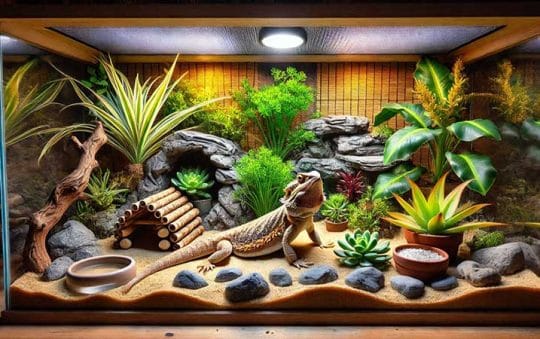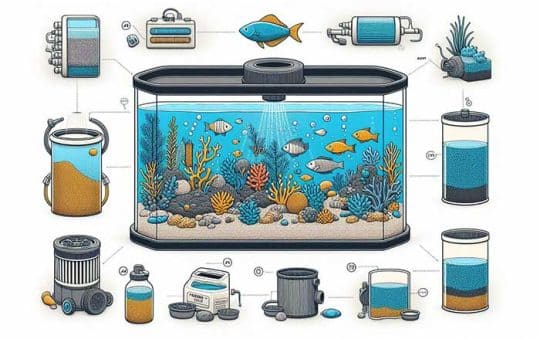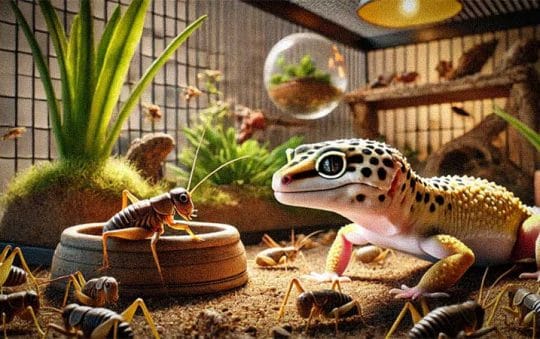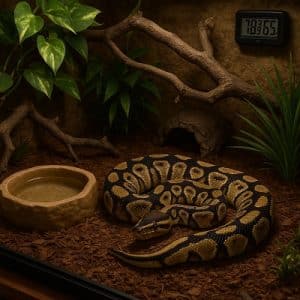
Ball pythons, scientifically known as Python regius, are native to West and Central Africa. Therefore, understanding their natural environment helps us recreate suitable living conditions in captivity. Moreover, these gentle reptiles can live 20-30 years with proper care, making habitat setup a worthwhile investment. Additionally, ball pythons are known for their docile temperament and manageable size, which makes them excellent pets for both beginners and experienced reptile enthusiasts.
Choosing the Right Terrarium Size
The first step in creating an appropriate ball python habitat is selecting the correct terrarium size. Initially, younger ball pythons do well in smaller enclosures that provide security and reduce stress. However, as they grow, you’ll need to upgrade their living space accordingly.
For baby and juvenile ball pythons, a 20-gallon terrarium is often sufficient. Nevertheless, adult ball pythons require a minimum of a 40-gallon terrarium to ensure they have enough space to move, explore, and exercise. Furthermore, the terrarium should be longer rather than taller, as ball pythons are terrestrial snakes that prefer horizontal movement over climbing.
When selecting a terrarium, look for these important features:
- Secure, lockable lid to prevent escapes
- Front-opening doors for easier access and less stressful interactions
- Adequate ventilation to maintain proper airflow
- Solid construction that retains heat efficiently
- Sufficient floor space for essential habitat elements
Remember that while ball pythons don’t require enormous enclosures, they do need enough space to fully stretch out, move around comfortably, and access different temperature zones within their habitat.
Essential Heating Elements for Your Ball Python Habitat
Ball pythons require a temperature gradient in their habitat to properly regulate their body temperature. Consequently, providing the right heating elements is crucial for their health and digestion. Moreover, maintaining appropriate temperatures helps prevent respiratory infections and other health issues.
Understanding Temperature Requirements
In the wild, ball pythons experience varying temperatures throughout the day. Therefore, your habitat should provide both a warm side (88-92°F) and a cooler side (75-80°F). Additionally, the temperature should drop slightly at night, mimicking natural conditions. Furthermore, consistent monitoring is essential to ensure your heating elements are functioning properly.
Selecting Appropriate Heating Options
There are several effective ways to heat your ball python habitat:
Under Tank Heat Pad
An under tank heat pad is often the preferred primary heat source for ball pythons. Most importantly, these heating pads provide the belly heat that ball pythons naturally seek when digesting meals. Furthermore, heat pads are installed beneath one side of the terrarium, creating the essential temperature gradient your snake needs.
When using an under tank heat pad, always connect it to a thermostat to prevent overheating. Additionally, placing the heat pad under 1/3 to 1/2 of the terrarium provides an adequate warm zone while leaving a cooler area for thermoregulation.
Ceramic Emitters and Overhead Heating
For additional ambient heating, ceramic emitters provide excellent supplementary warmth without producing light. Furthermore, these heating elements can be particularly useful during colder months or in air-conditioned rooms. Moreover, ceramic emitters can last for years, making them a cost-effective investment for your ball python habitat.
When installing ceramic emitters, always use appropriate fixtures rated for the wattage of your heating element. Additionally, position them securely above the enclosure at a safe distance to prevent accidental burns.
Radiant Heat Panels
Radiant heat panels represent another excellent option for heating your ball python habitat. Consequently, these panels produce infrared heat that penetrates deep into your snake’s body, aiding in digestion and overall health. Furthermore, radiant heat panels can be mounted inside the terrarium on the ceiling or wall, providing efficient, even heat distribution.
These panels are particularly useful for larger enclosures or those with solid tops that don’t accommodate traditional heat lamps. Additionally, like all heating elements, radiant heat panels must be connected to a reliable thermostat for safety.
Temperature Control and Monitoring
The Importance of Thermostats
A high-quality thermostat is perhaps the most critical safety component in your ball python habitat. In fact, unregulated heating elements can reach dangerous temperatures that could seriously injure or kill your snake. Therefore, investing in a reliable thermostat is non-negotiable for responsible snake keeping.
Thermostats work by monitoring the temperature and cutting power to heating elements when they reach the set temperature. Consequently, this prevents overheating and maintains a consistent temperature range. Furthermore, more advanced models offer programmable settings for day/night temperature fluctuations, adding another layer of naturalistic care.
Digital Thermometer/Hygrometer Placement
To properly monitor conditions in your ball python habitat, install at least two digital thermometer/hygrometer units. Specifically, place one on the warm side and another on the cool side of the enclosure. Moreover, positioning these devices at the substrate level, where your snake spends most of its time, provides the most accurate readings.
Digital thermometer/hygrometer combinations measure both temperature and humidity, essential parameters for ball python health. Additionally, models with probe sensors offer more precise readings than adhesive strip thermometers. Furthermore, regularly check and calibrate these devices to ensure accurate monitoring of your habitat conditions.
Creating Appropriate Humidity Levels
Maintaining proper humidity is essential for a healthy ball python habitat. Generally, humidity levels should range between 50-60% with short periods of higher humidity during shedding. Furthermore, consistent humidity helps prevent respiratory infections and ensures smooth, complete sheds.
Methods to Maintain Humidity
There are several effective ways to maintain appropriate humidity in your ball python habitat:
- Using a moisture-retaining substrate that can be misted
- Providing a large water bowl on the cool side of the enclosure
- Misting the habitat as needed (usually once or twice daily)
- Using a reptile fogger or humidifier for automatic humidity control
- Creating a humid hide filled with damp sphagnum moss for use during shedding
Monitor humidity levels regularly using your digital hygrometer and adjust your methods as needed. Additionally, be aware that excessive humidity can lead to scale rot and other health issues, so balance is key.
 Essential Hide Options for Security and Stress Reduction
Essential Hide Options for Security and Stress Reduction
Ball pythons are secretive animals that feel most secure when they have adequate hiding places. Therefore, providing multiple hide options is crucial for reducing stress in your ball python habitat. Furthermore, stressed snakes often refuse food and may experience health problems, making proper hide selection an important aspect of habitat setup.
Strategic Hide Placement
Your ball python habitat should include at least two identical hides – one on the warm side and one on the cool side. Consequently, this arrangement allows your snake to thermoregulate without sacrificing security. Moreover, the entrances to these hides should be just large enough for your snake to enter comfortably, as tight spaces create a sense of security.
Types of Hides
There are numerous hide options available for your ball python habitat:
- Commercial reptile caves and hides
- Cork bark pieces or hollow logs
- Clay flower pots turned on their sides
- Custom-built hides from safe materials
- Specialty humid hides for use during shedding
The most important factors are that the hide is snug, dark, and makes your snake feel secure. Additionally, avoid hides with rough or sharp edges that could injure your pet.
Proper Water Bowl Selection and Placement
A large, sturdy water bowl is an essential component of any ball python habitat. First and foremost, this provides drinking water for hydration. Furthermore, a properly sized water bowl contributes to ambient humidity and occasionally serves as a soaking spot for your snake.
When selecting a water bowl, choose one that is:
- Heavy enough to avoid tipping when your snake crawls over it
- Large enough for your snake to soak in if desired
- Easy to clean and disinfect regularly
- Made from non-porous, safe materials
- Shallow enough to prevent drowning risks
Place the water bowl on the cooler side of the habitat to prevent rapid evaporation and excessive humidity. Additionally, change the water daily and clean the bowl regularly to prevent bacterial growth.
Choosing the Right Substrate for Your Ball Python Habitat
Substrate selection significantly impacts the functionality and appearance of your ball python habitat. Most importantly, the substrate contributes to humidity management and provides a comfortable surface for your snake to move across. Furthermore, different substrate options offer various benefits and considerations.
Popular Substrate Options
Cypress Mulch
Cypress mulch is an excellent substrate choice for ball python habitats. Consequently, it holds humidity well while being resistant to mold. Furthermore, it’s a natural product that looks attractive in naturalistic setups. Additionally, cypress mulch is relatively affordable and easy to replace during habitat maintenance.
Coconut Husk Products
Coconut-based substrates like coconut husk or coir offer outstanding humidity retention for ball python habitats. Moreover, these products are sustainable and biodegradable. Furthermore, they’re available in various forms including loose substrate, compressed bricks, and bedding chips, providing flexibility in habitat design.
Paper-Based Products
For beginners or quarantine setups, paper-based substrates offer simplicity and cleanliness. Specifically, paper towels or newspaper provide an inexpensive, easily replaceable substrate option. Furthermore, these substrates make monitoring health and spotting waste extremely easy. However, they don’t contribute significantly to humidity and don’t look as natural as other options.
Substrates to Avoid
For safety reasons, avoid these substrates in your ball python habitat:
- Cedar or pine shavings (contain harmful oils)
- Sand (causes impaction if ingested)
- Gravel or small rocks (ingestion risk)
- Cat litter (contains chemicals and dust)
When installing substrate, provide a layer 2-4 inches deep to allow for burrowing behaviors. Additionally, spot clean daily and replace all substrate monthly or as needed to maintain a clean, healthy environment.
Enhancing Your Ball Python Habitat with Decor
While ball pythons don’t require elaborate decor, thoughtfully selected items enhance their habitat both functionally and aesthetically. Furthermore, appropriate decor provides environmental enrichment, giving your snake opportunities for exploration and natural behaviors.
Climbing Branches and Perches
Though not arboreal, ball pythons do occasionally climb in the wild. Therefore, providing some low climbing branches can enrich their captive environment. Furthermore, these structures create additional usable space within the terrarium. Moreover, branches can help with shedding by providing rough surfaces for your snake to rub against.
When selecting climbing branches for your ball python habitat, choose sturdy, sanitized options that won’t collapse under your snake’s weight. Additionally, avoid branches with sharp points or flaking bark that could cause injuries.
Fake Plants and Decor for Security
Artificial plants and decor serve multiple purposes in a ball python habitat. Most importantly, they provide additional security and visual barriers, increasing your snake’s comfort level. Furthermore, these items create a more naturalistic appearance that’s pleasing to the eye.
When selecting fake plants, choose ones specifically designed for reptile habitats, as these are typically more durable and safe. Additionally, secure all decor items firmly to prevent them from falling and potentially injuring your snake.
Lighting Requirements for Ball Python Habitats
Ball pythons don’t require special UVB lighting like some reptiles. However, providing a regular day/night cycle is important for their overall wellbeing. Consequently, a simple LED or low-wattage incandescent light can provide this cycling. Furthermore, the lighting should be on for approximately 12 hours daily, mimicking natural conditions.
If your room already has good natural light with a consistent day/night cycle, additional lighting may not be necessary. Additionally, avoid colored bulbs that distort your view of the snake and potentially stress the animal. Moreover, any lighting used should be positioned where your snake can’t come into direct contact with it to prevent burns.
Setting Up a Quarantine Habitat for New Ball Pythons
Before introducing a new ball python to its permanent habitat, setting up a temporary quarantine enclosure is highly recommended. Fundamentally, this helps identify any health issues and prevents the potential spread of parasites or diseases to other reptiles in your collection.
Quarantine Habitat Essentials
A quarantine ball python habitat should be:
- Simple and easy to clean
- Equipped with basic necessities (heat, hides, water)
- Set up with paper towels or newspaper substrate for easy monitoring
- Located away from other reptiles
- Maintained for 30-90 days before moving to a permanent setup
During quarantine, closely monitor your ball python’s eating, defecation, and overall behavior. Furthermore, consider a veterinary check-up during this period to ensure your new pet is healthy.
Maintenance Schedule for Your Ball Python Habitat
Regular maintenance ensures your ball python habitat remains clean, safe, and functional. Therefore, establishing a consistent schedule helps prevent health issues related to poor husbandry. Furthermore, routine maintenance becomes less time-consuming when done regularly.
Daily Maintenance Tasks
- Refresh water bowl with clean water
- Remove waste, shed skin, or soiled substrate
- Check temperatures and humidity levels
- Ensure all heating elements are functioning properly
- Observe your snake’s behavior and appearance
Weekly Maintenance Tasks
- Deep clean water bowl with mild disinfectant
- Spot clean substrate more thoroughly
- Wipe down glass or walls as needed
- Check for any damaged equipment or decor
- Adjust humidity methods if readings are inconsistent
Monthly Maintenance Tasks
- Replace substrate completely
- Disinfect all decor items and hides
- Clean and inspect all heating elements
- Calibrate thermostats and monitoring devices
- Evaluate overall habitat setup and make improvements
By following this maintenance schedule, you’ll ensure your ball python habitat remains in optimal condition. Additionally, regular maintenance helps you spot potential issues before they become serious problems.
Common Ball Python Habitat Mistakes to Avoid
Even experienced keepers can make mistakes when setting up a ball python habitat. Therefore, being aware of common errors helps ensure your setup provides the best possible environment for your pet.
Temperature-Related Mistakes
- Relying on heat rocks (burn risk)
- Not using a thermostat with heating elements
- Insufficient temperature gradient
- Measuring air temperature only instead of surface temperature
- Incorrect thermometer placement
Humidity-Related Mistakes
- Consistently too-dry conditions leading to difficult sheds
- Consistently too-wet conditions leading to scale rot
- Using misting as the only humidity method
- No humidity monitoring
- Improper substrate for humidity management
Enclosure Setup Mistakes
- Insufficient hides or security
- Too-large habitat for young snakes
- Unsecured lids or escape opportunities
- Mixing incompatible reptiles
- Using unsafe decor or substrate materials
By avoiding these common mistakes, you’ll create a safer, more appropriate ball python habitat. Furthermore, learning from others’ experiences helps prevent unnecessary stress for both you and your snake.
Conclusion
Creating the perfect ball python habitat involves careful consideration of numerous factors including temperature, humidity, security, and enrichment. Consequently, taking the time to set up a proper environment from the beginning leads to a healthier, happier snake. Furthermore, many common health issues can be prevented through appropriate habitat design and maintenance.
Remember that your ball python habitat may require adjustments over time as you learn your individual snake’s preferences. Additionally, upgrading elements of the habitat as your snake grows ensures their needs continue to be met throughout their long lifespan. Moreover, joining reptile keeping communities can provide valuable insights and support as you perfect your ball python habitat.
With the information provided in this guide, you’re well-equipped to create an excellent home for your new ball python. Therefore, take your time, invest in quality equipment, and enjoy the rewarding experience of keeping these fascinating reptiles.
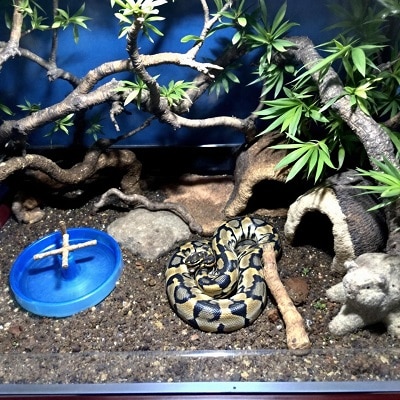
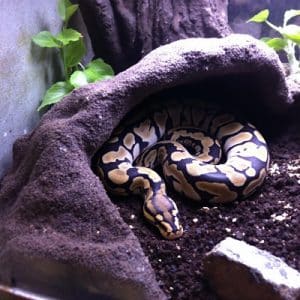 Essential Hide Options for Security and Stress Reduction
Essential Hide Options for Security and Stress Reduction